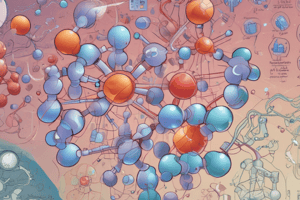Podcast
Questions and Answers
How does mifepristone work?
How does mifepristone work?
- It activates the glucocorticoid receptor, increasing its affinity for DNA.
- It directly inhibits the transcription of target genes.
- It acts as a ligand for the glucocorticoid receptor, activating transcription.
- It blocks the binding of a ligand to the glucocorticoid receptor. (correct)
What is the primary mechanism by which glucocorticoids regulate gene expression?
What is the primary mechanism by which glucocorticoids regulate gene expression?
- They stimulate the production of specific transcription factors. (correct)
- They directly bind to DNA and activate transcription.
- They alter the conformation of DNA to make it more accessible to transcription factors.
- They interact with ribosomes to enhance protein synthesis.
Which of the following drugs may increase the required dose of glucocorticoids due to their interaction with the CYP3A4 enzyme?
Which of the following drugs may increase the required dose of glucocorticoids due to their interaction with the CYP3A4 enzyme?
- Ritonavir
- Darunavir
- Phenytoin (correct)
- Methotrexate
Which of the following statements is TRUE regarding glucocorticoid-mediated gene regulation?
Which of the following statements is TRUE regarding glucocorticoid-mediated gene regulation?
Which of the following best describes the effect of glucocorticoid drugs on the gastrointestinal tract when combined with nonsteroidal anti-inflammatory drugs (NSAIDs)?
Which of the following best describes the effect of glucocorticoid drugs on the gastrointestinal tract when combined with nonsteroidal anti-inflammatory drugs (NSAIDs)?
Which structural feature is NOT required for glucocorticoid receptor (GR) activity?
Which structural feature is NOT required for glucocorticoid receptor (GR) activity?
Which structural modification is associated with increased stability of glucocorticoids and a decreased rate of metabolism?
Which structural modification is associated with increased stability of glucocorticoids and a decreased rate of metabolism?
What is the primary mechanism of action of prednisone?
What is the primary mechanism of action of prednisone?
Which factors can impair prednisone absorption?
Which factors can impair prednisone absorption?
Which of the following is TRUE regarding the potential adverse effects of glucocorticoids?
Which of the following is TRUE regarding the potential adverse effects of glucocorticoids?
What is the primary function of the adrenal cortex?
What is the primary function of the adrenal cortex?
Which of the following hormones is secreted by the adrenal medulla?
Which of the following hormones is secreted by the adrenal medulla?
Which glucocorticoid is considered short-acting?
Which glucocorticoid is considered short-acting?
What role do releasing hormones from the hypothalamus play in the endocrine system?
What role do releasing hormones from the hypothalamus play in the endocrine system?
Which drug is an antagonist for mineralocorticoids?
Which drug is an antagonist for mineralocorticoids?
What distinguishes synthetic glucocorticoids from natural ones?
What distinguishes synthetic glucocorticoids from natural ones?
Which steroid hormone is primarily responsible for the regulation of sodium and potassium levels in the body?
Which steroid hormone is primarily responsible for the regulation of sodium and potassium levels in the body?
Which drug is NOT a glucocorticoid?
Which drug is NOT a glucocorticoid?
Flashcards
How do GCs affect salicylate excretion?
How do GCs affect salicylate excretion?
Glucocorticoids (GCs) enhance the excretion of salicylates (aspirin) from the body.
What is the effect of GCs on hypoglycemic agents?
What is the effect of GCs on hypoglycemic agents?
GCs can diminish the effectiveness of medications used to lower blood sugar levels.
What is the side effect of fluoroquinolones related to tendons?
What is the side effect of fluoroquinolones related to tendons?
Fluoroquinolone antibiotics, like levofloxacin, increase the risk of tendon rupture.
How do contraceptives affect GC metabolism?
How do contraceptives affect GC metabolism?
Signup and view all the flashcards
What is Prednisone?
What is Prednisone?
Signup and view all the flashcards
Glucocorticoid Receptor Activation
Glucocorticoid Receptor Activation
Signup and view all the flashcards
CYP3A4 and Glucocorticoids
CYP3A4 and Glucocorticoids
Signup and view all the flashcards
Glucocorticoid Interaction with NSAIDs
Glucocorticoid Interaction with NSAIDs
Signup and view all the flashcards
CYP3A4 Inducers
CYP3A4 Inducers
Signup and view all the flashcards
CYP3A4 Inhibitors
CYP3A4 Inhibitors
Signup and view all the flashcards
Endocrine System
Endocrine System
Signup and view all the flashcards
Adrenocorticoids
Adrenocorticoids
Signup and view all the flashcards
Hypothalamus
Hypothalamus
Signup and view all the flashcards
Pituitary Gland
Pituitary Gland
Signup and view all the flashcards
Hypothalamus-Pituitary-Thyroid (HPT) Axis
Hypothalamus-Pituitary-Thyroid (HPT) Axis
Signup and view all the flashcards
Adrenal Glands
Adrenal Glands
Signup and view all the flashcards
Adrenal Cortex
Adrenal Cortex
Signup and view all the flashcards
Glucocorticoid
Glucocorticoid
Signup and view all the flashcards
Study Notes
Endocrine Pharmacology: Adrenocorticoids
- Adrenocorticoids are a class of drugs that affect the adrenal glands, which are located above the kidneys.
- Adrenal glands have two parts: the cortex and the medulla.
- The adrenal cortex secretes various hormones, including mineralocorticoids (e.g., aldosterone) and glucocorticoids (e.g., cortisol).
- Aldosterone regulates sodium balance.
- Cortisol modulates metabolism.
- The hormones from the adrenal glands have related, but distinct effects.
- The hypothalamus has a significant role in regulating the function of the anterior pituitary gland, and in turn hormones.
Hypothalamus-Pituitary-Endocrine Axes
- The hypothalamus produces releasing hormones to stimulate/inhibit pituitary hormones.
- The pituitary gland synthesizes and releases hormones into circulation.
- Circulating hormones act on specific endocrine glands/tissues, producing various biological effects.
- The hypothalamus-pituitary-thyroid (HPT) axis is an example of this axis.
Normal Anatomy of the Adrenal Glands
- Adrenal glands are small yellowish structures located at the top of each kidney.
- They are situated in the perirenal space, positioned superior and anterior to the kidneys.
Adrenal Glands: Medulla and Cortex
- Adrenal glands have two functional regions: the adrenal medulla and the adrenal cortex.
- Different regions of the Adrenal cortex have varying functions.
- The adrenal cortex produces hormones with various functions, including mineralocorticoids (e.g., aldosterone) and glucocorticoids (e.g., cortisol).
The Adrenal Cortex
- The adrenal cortex acts like a typical endocrine gland.
- It primarily secretes steroid hormones including aldosterone, cortisol, and sex hormones.
- These steroids are produced through a complex series of enzymatic steps.
Synthesis of Adrenocortical Hormones
- Adrenocortical hormones are derived from cholesterol and synthesized through enzymatic reactions.
- Various enzymes are involved at various stages of hormone creation.
- The different pathways create different types.
Drugs Covered in this Section: Glucocorticoids and Mineralocorticoids
- Synthetic corticosteroids like prednisone, prednisolone, triamcinolone, betamethasone, and dexamethasone are involved.
- Natural corticosteroids like hydrocortisone are part of the therapy.
- Mineralocorticoids like aldosterone, deoxycorticosterone, and fludrocortisone are included.
- Specific categories of antagonists such as inhibitors of synthesis and receptor blockers are included.
Cellular Response of Steroid Signaling
- Steroid hormones bind to specific intracellular receptors.
- This leads to changes in gene expression and subsequent cellular effects.
- Glucocorticoids, for instance, can regulate glucose metabolism.
Drug Interactions with Glucocorticoids
- Glucocorticoids (GCs) can interact with other drugs.
- Some drugs increase or inhibit the activity of the enzymes metabolizing GCs.
- Other drugs might be affected by the GCs.
Glucocorticoid Structure and Activity
- Specific structural features of glucocorticoids are critical for their activity.
- The structure dictates how a specific glucocorticoid acts in the body.
- Structural modifications can impact both potency and activity of the hormone.
Glucocorticoids: Structures
- Different structures of glucocorticoids and some relevant metabolites are described and compared.
Prednisone
- Prednisone is a synthetic glucocorticoid.
- Prednisone's mechanism of action mimics the effects of natural glucocorticoids.
- Prednisone has a specific metabolism and excretion profile distinct from others.
- Prednisone is frequently used in various conditions to treat inflammatory and immune responses.
Hydrocortisone (Cortisol)
- Hydrocortisone, or cortisol, is a naturally occurring glucocorticoid.
- It has a significant amount of action and affects multiple body systems.
- Hydrocortisone's action and metabolism have effects on bodily functions.
Adrenal Gland Diseases
- Congenital adrenal hyperplasia (CAH) is often caused by a deficiency of an enzyme involved in steroid synthesis.
- Adrenocortical insufficiency can manifest as Addison's disease, characterized by insufficient production of glucocorticoids and mineralocorticoids.
- Cushing's syndrome is caused by overproduction of cortisol.
- Primary aldosteronism results from overactivity of the adrenal gland producing aldosterone.
- Secondary aldosteronism results from overactivity of the renin-angiotensin-aldosterone system.
- Pheochromocytoma is a tumor of the adrenal medulla that typically produces excess catecholamines.
Diagnosing Adrenal Gland Conditions
- Various tests are used to help diagnose different adrenal conditions.
- These tests typically focus on evaluating hormone levels and responses.
Treatment of Adrenal Gland Conditions
- Treatment strategies vary based on the specific adrenal condition.
- These can involve hormone replacement, surgery, or other methods.
Mineralocorticoids (Aldosterone, Deoxycorticosterone, Fludrocortisone)
- Mineralocorticoids (e.g., aldosterone) are crucial for regulating sodium and potassium balance.
- They affect sodium reabsorption and potassium secretion.
- Fludrocortisone is a synthetic mineralocorticoid used to treat mineralocorticoid deficiency.
Mineralocorticoid Antagonists
- Drugs such as spironolactone, eplerenone, drospirenone, and finerenone are mineralocorticoid antagonists.
- These agents block the effects of aldosterone and reduce sodium retention.
- These antagonists have varied mechanisms and clinical uses to treat various conditions.
Studying That Suits You
Use AI to generate personalized quizzes and flashcards to suit your learning preferences.

